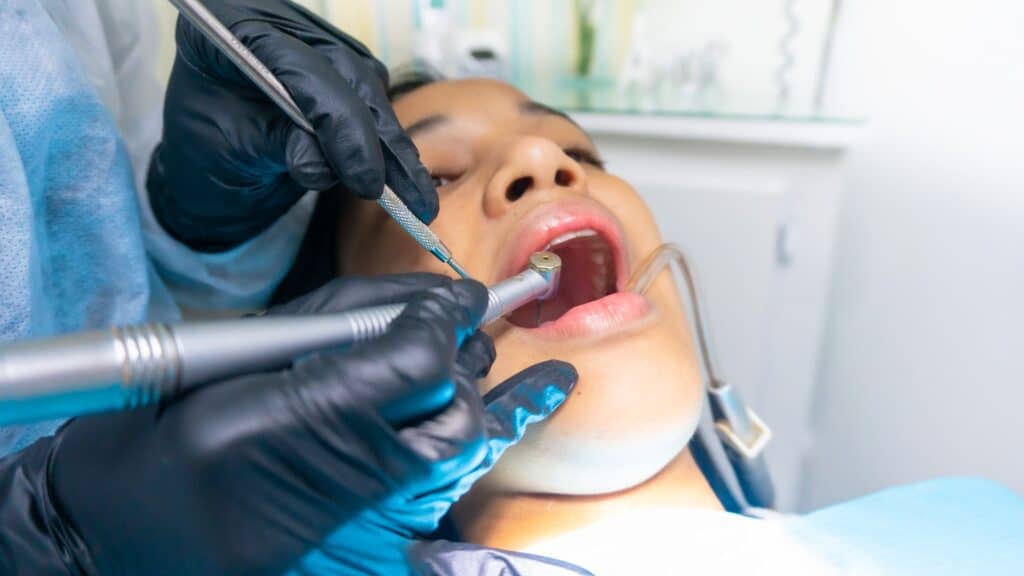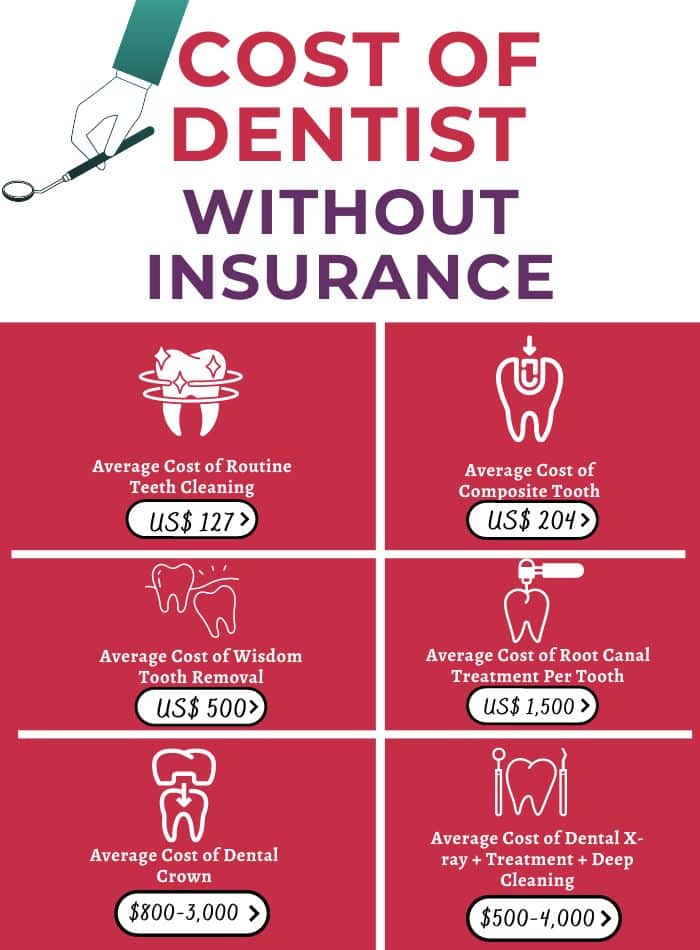Cost of Dentists Without Insurance – Overview
The high cost of dental healthcare services is one of the reasons most people won’t go to a dentist, according to the American Dental Association.
Besides, the cost of visiting a dentist without insurance is on par with your annual insurance bill.
However, the high cost is justified by the impressive advances that modern dental science has made. These advances have helped to treat and prevent numerous dental diseases.
Constant advances result in a gradual rise in the cost of dental services. This means more people will find it expensive to visit a dentist and maintain good oral health.
Still, there are ways that you can visit a dentist without insurance.
How to Get Dental Work Without Insurance?

According to industry statistics, around 65 million Americans have no dental insurance. These tens of millions of people have to pay for dental services out of their pockets.
This has caused most people to relegate dentist visits to twice a year.
Most people are unaware that this lax attitude to visiting a dentist for fear of dental costs may eventually cost significantly more.
So, if you are among the 70+ million Americans without dental insurance but suffering from dental problems, here are some ways to seek help:
1 – Dental Schools
You can receive quality treatment at a lower cost than private dental offices at an accredited dental school.
Dental schools have clinics where dental students can work under the supervision of licensed and experienced dentists.
You can be assured that the licensed dentist keeps a close eye on the work of the dental student at every stage. This ensures that patients get quality and affordable treatment.
However, the catch is that you may need to visit the dental school more often.
2 – Medicaid, Medicare, CHIP
Medicare does not cover most routine dental care, including fillings, cleanings, and extractions.
However, Medicare Part A does offer coverage for select emergency dental treatments that are provided at a hospital.
Every state is obliged to provide Medicaid benefits to children enrolled in the program. Some of these states offer additional dental coverage for adults. Even children can receive an oral screening from a physician, not a dentist, under this scheme.
At a minimum, Medicaid offers the following dental care covers to children:
- Restoration of decayed and broken teeth
- Treatment necessary to relieve dental pain and infections
- Dental procedures that are essential to maintain the child’s oral health
The U.S. federal government collaborates with state governments to offer low-cost health coverage for children who do not qualify for Medicaid due to the low-income status of the family. This initiative is called the State Children’s Health Insurance Program, or CHIP.
3 – Local health departments
Some local health departments provide low-cost or free dental services to eligible individuals.
To find the nearest local health department, check the official HHS website at https://www.hhs.gov/answers/health-insurance-reform/.
If you want to find the nearest federally funded dental clinic near you, visit this link https://findahealthcenter.hrsa.gov/.
4 – Payment options
In case you do not have dental insurance and cannot access any of the above-listed assistance, then you can find a dentist who offers different payment options for their services.
What is the cost of a Dentist visit without Insurance?
The cost of routine dental services, such as teeth cleaning, varies, often ranging from $75 to $200.
The combined cost of a dental cleaning and x-rays can exceed $300, depending on the dentist and location. Deep cleaning costs can vary, typically ranging from $150 to $350 per quadrant, making the total cost potentially high for full-mouth treatment.
Even with dental insurance, you may still have to pay several hundred dollars for this procedure out of pocket.
The affordability of paying for dental visits out of pocket versus having insurance depends on individual circumstances and the type of dental care needed.
This works well if you only need essential dental services, such as exams and cleaning each year.
Those with dental insurance often pay out of pocket because their carrier has a limited provider network. In addition, some dental plans have a low annual maximum, which makes paying their monthly premium a task.
Let’s take a quick look at the average cost of specific dental treatments in the United States:

1 – Teeth Cleaning
Those with dental insurance can receive coverage for teeth cleaning twice a year. On average, teeth cleaning at a dentist’s clinic costs around $127.
Several variables determine the total cost of a dental cleaning, including:
- State of your oral health
- Location of the dentist
- Type of cleaning needed
- Having dental insurance (or not)
- Need for prescription toothpaste or at-home product from the dentist
2 – Composite Tooth Filling
The size of the cavity and the material being used for the filling will determine the exact cost of a composite tooth-filling procedure.
On average, tooth-colored or composite fillings to restore one surface costs around $90 to $250, and $150 to $450 to restore three or more surfaces.
With dental insurance, you get coverage that pays around 50 to 80% of the cost, so the average cost of composite tooth filling without dental insurance is around $204.
3 – Wisdom Tooth Removal
It is affordable and cost-effective to get all your wisdom teeth removed at the same time.
Without insurance, you may pay $250 to $750 for wisdom teeth removal.
4 – Root Canal Treatment
A dental insurance policy typically covers between 50% and 80% of the total cost of a root canal treatment after meeting the deductible. You may need to pay part of the cost of a dental crown if recommended by the dentist.
There are several other limitations, too. Sometimes, you may need to meet specific clinical criteria to be eligible for this facility.
The total cost of a root canal treatment usually covers the following:
- Anesthetic fees
- X-ray or other imaging test costs
- Treatment or procedure cost
Remember, the dentist’s consultation fee is not included in this. In addition, the total cost of root canal treatment usually does not include the cost of final tooth restoration, such as a crown or a new filling.
A dental crown is usually recommended if the root canal is done on a molar.
The average cost of a dental crown is around US$1,300, but it varies depending on the material. You can choose metal crowns, ceramic crowns, porcelain-metal crowns, or even zirconia crowns.
5 – Dental Crown
The cost of a dental crown procedure will depend on the type of materials being used.
People with dental insurance may still need to pay around $530 to $1,875 out of pocket for a porcelain crown. People without dental insurance may need to pay up to $800 to $3,000 for fixing dental crowns.
Conclusion
Despite the rising cost of dental services and insurance premiums, it is highly advised to buy an affordable dental insurance plan.
If you cannot purchase dental insurance for some compelling reason, you should ensure that you approach the nearest dental school or the local health departments and receive dental treatment for good oral health.
See Also
Dental Braces Without Insurance
Dental Cleaning
What Happens if an Employer Terminates Health Insurance Without Notice?
Medical Care Without Insurance